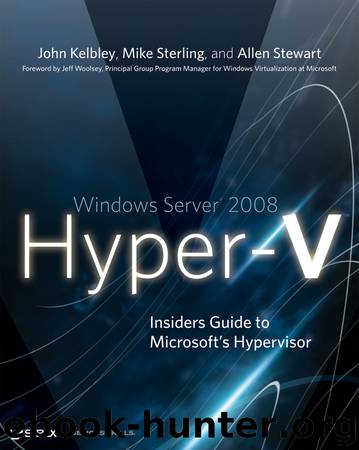Windows Server 2008 Hyper-V: Insiders Guide to Microsoft's Hypervisor by John Kelbley & Mike Sterling & Allen Stewart

Author:John Kelbley & Mike Sterling & Allen Stewart
Language: eng
Format: epub
Publisher: Wiley Publishing, Inc.
Published: 2011-01-06T16:00:00+00:00
Figure 9-4: WMI virtualization provider
Accessing WMI
The key to unlocking the value of WMI is to understand where relevant information may lie. Windows offers more than 100 providers to access system components, including the event log, the Registry, performance counters, and so on. Software developers—including Microsoft—can add new providers, and that is what has been done for Hyper-V. The virtualization WMI provider exposes a rich interface that lets you monitor and control Hyper-V and the virtual environment.
WMI organizes information on a given computer into namespaces. Information about the computer’s hard disk, operating system, hotfixes, and so on, are found in the root\cimV2 namespace. Hyper-V uses the root\virtualization namespace.
Properties of objects that are accessible through WMI (like a VM name) are organized into groups called classes. Hotfixes have a class, processors have a class, and VMs have a class named MSVM_ComputerSystem. There may be one or more instances of an object class. For example, on a system with four VMs, there are four instances of the MSVM_ComputerSystem object, one for each VM (and a fifth for the parent partition).
WMI classes for a provider are commonly accessed via the corresponding namespace. The namespace that corresponds to the classes made available by the virtualization provider is \root\virtualization. Scripting tools access WMI through a WMI scripting library. The WMI scripting library provides the set of script-enabling objects to access the WMI infrastructure.
WMI Security
WMI uses Windows security to validate logon information on local computers and for remote access. WMI enforces security for resources at the level of individual namespaces. For the purposes of all WMI-related examples in this book, it’s assumed that you’ll execute them with full administrative access to the parent partition and the underlying WMI namespaces.
NOTE The security check for WMI occurs only when a user logs in. Changes to user access (including access revocation) take effect the next time a user logs on.
Download
This site does not store any files on its server. We only index and link to content provided by other sites. Please contact the content providers to delete copyright contents if any and email us, we'll remove relevant links or contents immediately.
Exploring Deepfakes by Bryan Lyon and Matt Tora(8126)
Robo-Advisor with Python by Aki Ranin(8057)
Offensive Shellcode from Scratch by Rishalin Pillay(6304)
Microsoft 365 and SharePoint Online Cookbook by Gaurav Mahajan Sudeep Ghatak Nate Chamberlain Scott Brewster(5448)
Ego Is the Enemy by Ryan Holiday(5261)
Management Strategies for the Cloud Revolution: How Cloud Computing Is Transforming Business and Why You Can't Afford to Be Left Behind by Charles Babcock(4507)
Python for ArcGIS Pro by Silas Toms Bill Parker(4376)
Elevating React Web Development with Gatsby by Samuel Larsen-Disney(4100)
Machine Learning at Scale with H2O by Gregory Keys | David Whiting(4046)
Liar's Poker by Michael Lewis(3344)
Learning C# by Developing Games with Unity 2021 by Harrison Ferrone(3321)
Speed Up Your Python with Rust by Maxwell Flitton(3261)
OPNsense Beginner to Professional by Julio Cesar Bueno de Camargo(3234)
Extreme DAX by Michiel Rozema & Henk Vlootman(3210)
Agile Security Operations by Hinne Hettema(3150)
Linux Command Line and Shell Scripting Techniques by Vedran Dakic and Jasmin Redzepagic(3139)
Essential Cryptography for JavaScript Developers by Alessandro Segala(3107)
Cryptography Algorithms by Massimo Bertaccini(3035)
AI-Powered Commerce by Andy Pandharikar & Frederik Bussler(3011)
